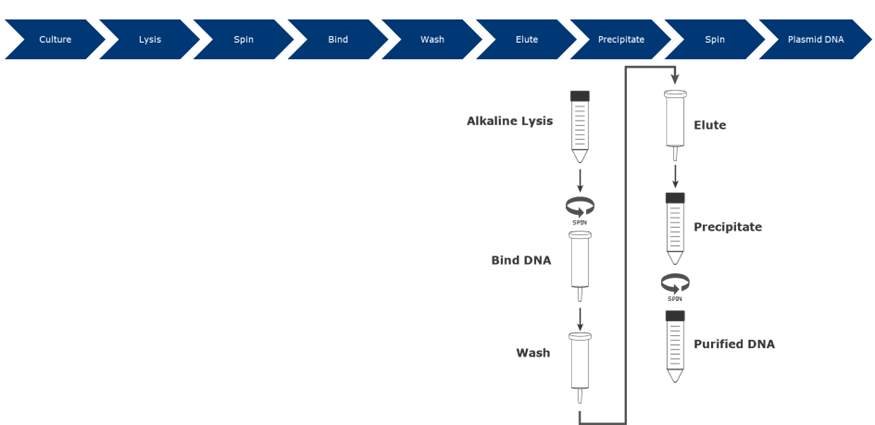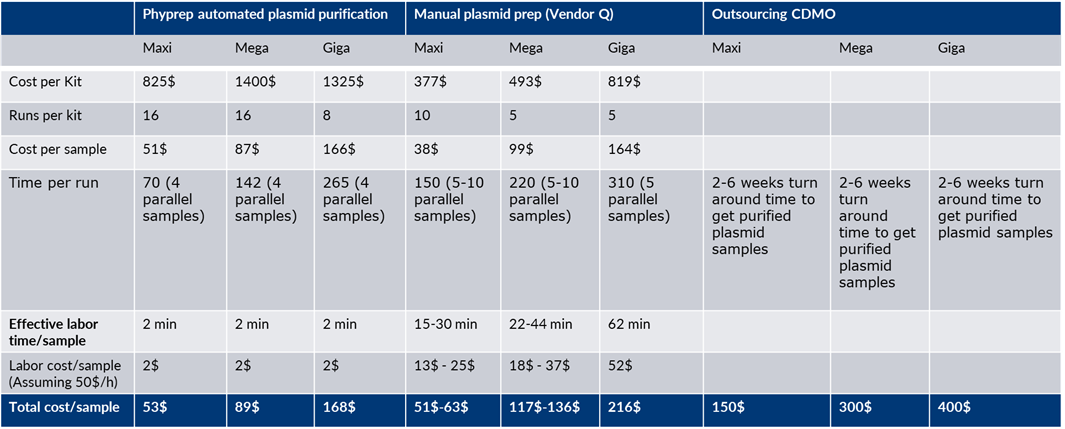Plasmids are an indispensable tool that are used to clone, transfer, and manipulate genes. These small, circular fragments of DNA are typically found in bacteria but are also present in some archaea and eukaryotes. They carry only a few genes which makes them easy to genetically modify.
It is this ease of manipulation, combined with their fast reproduction and long-term stability that make plasmids the starting point for a lot of modern research. For example, the recent advancements in DNA vaccines, mRNA vaccines, and monoclonal antibodies would not have been possible without them.
While plasmids exist naturally, most of those used in laboratory settings are artificially made. For scientists working in areas that use plasmids, such as molecular and cell biology, plasmid purification is a fundamental technique1. This technique can be both costly and labor intensive, especially if the plasmids are intended for use in transient transfections. Plasmids used for the mass production of proteins and viral vectors must be of very high quality and purity to ensure that successful transfections take place. While the protocols for the purification of plasmids are relatively well developed, numerous steps are not only time-consuming but also increase the chances of errors occurring. Here we will discuss different approaches to plasmid purification for use in research and drug discovery and development, highlighting the benefits and drawbacks of each and evaluating the costs associated with each approach.
Plasmid Purification Process
There are three basic steps involved in the production of plasmids: (1) Growth of bacterial culture, (2) Harvesting and lysis of the bacteria, and (3) Purification of the plasmid DNA. The purification step is highly important, yet plasmid purification protocols have not altered much over the last 40 years and remain highly time-consuming and labor-intensive.

Figure 1. Workflow of the manual plasmid preparation process
During plasmid purification, the bacterial cells are first centrifuged and lysed. Lysing releases DNA and other cellular components from the cell. The cellular components can then be removed using precipitation and centrifugation before the remaining supernatant is further processed to purify the plasmid DNA. This process involves a chromatography step which is a process that enables components within a mixture to be separated. In the case of plasmid purification for transfection, this step usually uses an anion chromatography set up to reduce endotoxin levels. The elution buffer used to obtain the plasmid from the column is often high in salt and results in a diluted product. This means that a final alcohol precipitation step is commonly used to reduce the salt concentration and increase the concentration of the plasmid so that it can be used to achieve effective transfection.
Plasmid purification for transfection can be done in one of three ways: using a manual kit, outsourcing the procedure to a commercial contract research organization (CRO), or by using an automated system. Let's look at each one in more detail.
Manual plasmid purification using commercial kits
Manual kits are the gold standard in plasmid purification for research and drug discovery and development. As a result, there are a wide range of commercial kits available depending on your needs, from Mini preparations up to Giga preparations. These kits offer a streamlined protocol that has many benefits, including high purity and good yields as well as endotoxin removal steps that make the resulting plasmid suitable for transfection. The main drawback to this method is the highly manual and labor-intensive steps associated with the procedure. For example, when preparing a Maxi purification, you can expect it to take approximately 150 minutes to run 5 to 10 samples in parallel, which means 15 to 30 minutes per sample. For a Giga purification, this time increases to 310 minutes for 5 samples or 62 minutes per sample. Prices per sample typically range from $38 to $164 depending on the scale of the kit being used. However, labor costs also need to be factored in which means that the average cost per sample can range anywhere from $51 to $216. (See table 1). Note that cost of labor can vary between countries and regions and therefore impact the outcome of this calculations. The general function and trade-off between labor time and cost will be similar although at different levels. In table 1 below the assumed labor cost (Full Time Employee (FTE)) was 50$/h.

Table 1. Plasmid purification running cost comparison
Assumptions:
Running up to 10 samples in parallel in manual Maxi and Mega Preps and up to 5 samples in parallel for Giga Preps.
Labor cost 50$/h (Based on FTE 95 000$/year. 262 working days/year and 7.5 h/day)
List prices from respective supplier are used in the calculations
Processing times Vendor Q; 150 min Maxi, 220 min Mega, 310 min Giga.
Manual labor time PhyPrep: 8 min including initial set up for a 4 sample parallel run
Outsourcing plasmid purification
Another available option is to outsource the plasmid purification step to a contract research organization (CRO). CROs offer a range of services from Mini preps through to Giga preps. There are several advantages and disadvantages to outsourcing your plasmid preps. One advantage is that this removes the in-house labor time and associated costs associated with manual methods, saving you considerable time in the lab which can then be devoted to other activities. On the downside, outsourcing can result in considerable lead times, and you can expect to wait several weeks to receive your purified plasmid samples. Outsourcing of plasmids have become a bottleneck the last few years due to the high demand of plasmids. Outsourcing is also significantly more expensive than manual methods, ranging from $150 - $400 per sample or more depending on the scale of your preparations (see table 1).
Automated plasmid purification
Automated plasmid purification systems have emerged in the last few years as an alternative for effective plasmid purifications. The PhyPrep instrument from Biotage for example, can be used for Maxi, Mega and Giga purifications. This system requires only a few minutes of your time for the initial sample preparation which means that the labor-associated costs per sample are much lower than the manual purification procedure discussed above. It will also enable researchers to spend their time on more challenging task. The purity and yield will be comparable to the manual plasmid purification methods2. In addition, the salt concentration of the elution buffer is significantly lower than the manual kits which enables the opportunity to skip the final alcohol precipitation step without compromising the transfection efficiency of your samples. This will further reduce the time spent on the plasmid purification process. Automating a process also implies that the reproducibility and consistency between preparations will be higher. The running cost becomes competitive and costs per sample range from $53 to $168 depending on the scale of your preparation.
Summary
Plasmids are an important biological tool that are the starting material for many advanced therapeutics. Plasmid purification is an important step in obtaining pure plasmids but many of the protocols used have not changed for 40 years. While manual kits are cost-effective, they require a lot of time, resulting not only in long hours spent at the lab bench but also in high labor costs. Outsourcing plasmid purification is another option that reduces time spent in the lab and release time for your own laboratory personnel. However, the lead times and costs associated with this are significantly higher. Biotage has developed an automated system that not only reduces time spent at the bench but is also cost-effective, with samples costing similar or less to process than it would with a manual kit without compromising the quality. Allowing researchers to spend their time on more challenging tasks.
To learn more about the PhyPrep system, click on the button below.
Learn More- Staedler, R.Lemmens, T.Nyhammar, ”Plasmid DNA purification”, J Gene Med, 2004 Feb;6 Suppl. 1:S54-66.
- Application Note. “The Biotage® PhyPrep Maxi Mega Giga Instrument and fully Automated Plasmid Purification for Transient Transfection and Mammalian Protein Production”

 Organic Workflow
Organic Workflow Peptide Workflow
Peptide Workflow Scale-Up Flash Purification
Scale-Up Flash Purification  Sample Preparation
Sample Preparation Biomolecule Purification
Biomolecule Purification Oligo synthesis
Oligo synthesis Scavengers and Reagents
Scavengers and Reagents Service & Support
Service & Support Accessories & Spare parts
Accessories & Spare parts Investors
Investors Reports & News
Reports & News The Share
The Share Corporate Governance
Corporate Governance Calendar
Calendar Sustainability
Sustainability Our Offering
Our Offering Our History
Our History Our Locations
Our Locations Leadership
Leadership